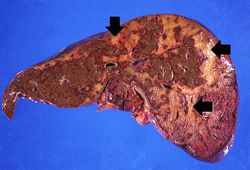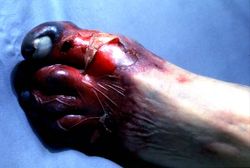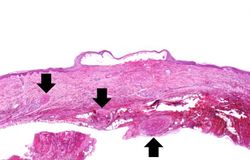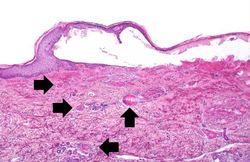IPLab:Lab 12:Acetaminophen Toxicity
Contents
Clinical Summary[edit]
This 77-year-old white male with a past medical history of osteo- and rheumatoid arthritis went to his internist for treatment of increasing joint pain and was started on a muscle relaxant, a narcotic analgesic that also contained 650 mg of acetaminophen, and a non-steroidal anti-inflammatory agent. The patient's medical record also indicated that he self medicated with acetaminophen. Two days later he went back to his doctor complaining of nausea and vomiting, right upper quadrant pain, anorexia, and confusion. Lab evaluation revealed increased liver function tests (AST, 2190; ALT, 1959; LDH, 5020; alkaline phosphatase, 120; GGT, 125; total bilirubin, 3.9). Hepatitis serologies were negative. The patient's blood acetaminophen level was 45 mcg/dL. Over the next several days the patient began to develop petechiae which progressed to ecchymosis and necrosis of his hands and feet. Laboratory studies revealed that the liver function was improving, but coagulation studies were consistent with DIC (platelets, 19,000; FDP, greater than 40; fibrinogen, 90; PTT, 26). The patient was treated with heparin, cryoprecipitate, fresh frozen plasma, and anti-thrombin III. Despite improvement in his coagulation parameters, the patient appeared to have ongoing thrombosis. The patient was evaluated by orthopedic and vascular surgery who recommended bilateral below-the-knee amputations and bilateral hand amputations. However, the patient was found apneic and, in keeping with his request that he not be resuscitated, no resuscitative measures were undertaken.
Autopsy Findings[edit]
There were petechia and ecchymoses all over the body. The skin on the hands, feet, and in patches over the entire body was deep purple, the epidermis was friable and there were large areas of desquamation. The fingertips and toes were black and dry. The liver had large areas of pale softened tissue indicative of liver necrosis.
Images[edit]
Virtual Microscopy[edit]
Liver: Acetominophen Toxicity[edit]
Normal Liver[edit]
Study Questions[edit]
Additional Resources[edit]
Reference[edit]
- eMedicine Medical Library: Acetaminophen Toxicity
- eMedicine Medical Library: Acute Liver Failure
- Merck Manual: Acetaminophen Poisoning
Journal Articles[edit]
- Schiødt FV, Lee WM, Bondesen S, Ott P, Christensen E. Influence of acute and chronic alcohol intake on the clinical course and outcome in acetaminophen overdose. Aliment Pharmacol Ther 2002 Apr;16(4):707-15.
- Yeates PJ, Thomas SH. Effectiveness of delayed activated charcoal administration in simulated paracetamol (acetaminophen) overdose. Br J Clin Pharmacol 2000 Jan;49(1):11-4.
Images[edit]
Related IPLab Cases[edit]
| |||||
A normal aspartate aminotransferase (AST) for a male is <37 U/L.
A normal alanine aminotransferase (ALT) is 7 to 56 U/L.
A normal lactate dehydrogenase level is 120 to 240 U/L.
A normal alkaline phosphatase is 39 to 117 U/L.
A normal gamma-glutamyl transpeptidase (GGT) is 0 to 65 U/L.
A normal total bilirubin level is 0 to 1.0 mg/dL.
A therapeutic acetaminophen level 10-40 mcg/dL.
A normal platelet count is 150,000 to 400,000/ml.
In a normal patient, fibrin degradation products should be less than 10 mcg/dL.
The normal fibrinogen level is 184 to 412 mg/dL.
A normal partial thromboplastin time is 28 to 37 seconds.
Friable material is easily crumbled.







